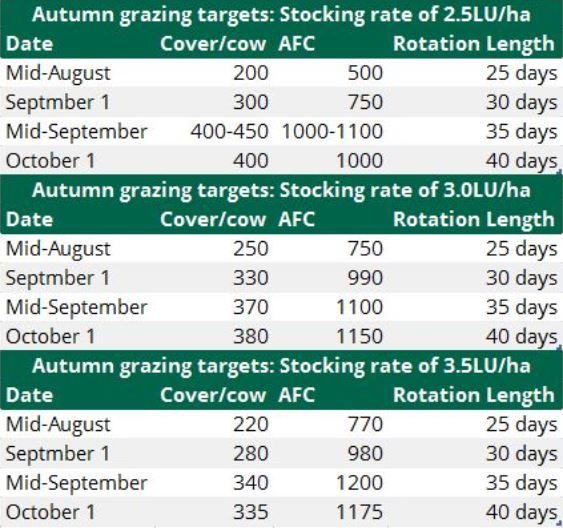Dairy farmers should start planning for spring grass supplies now, according to Teagasc’s Micheal O’Leary.
The Teagasc Pasturebase Ireland Administrator said that the ‘autumn magic day’ (the day when demand equals growth on many farms) is fast approaching.
O’Leary said that farmers need to start focusing on the length of their rotation and the average farm cover on their farms, as failing to do could have a negative impact on grass supplies next spring.
“For each week delay in closing in autumn, spring grass accumulation is reduced by 77 kg DM/ha.
Autumn closing date has a very significant impact on what level of grass is available the following spring.
Are you hitting your autumn grazing targets?
According to Teagasc, the autumn grazing targets vary from farm-to-farm and are dependent on stocking rate and soil type.
It shows that the higher the stocking rate the more ground the farmers need to have grazed by November 1.
Highly stocked farms (3.5LU/ha) need to have at least 70% of the farm grazed by November 1, while farmers with a stocking rate of 3LU/ha and 2.5LU/ha should aim to have 65% and 60% of the farm grazed by November 1.
Following these grazing guidelines will allow dairy farmers to get the most from spring grass next year.
One of the key steps to ensure that these targets are obtained is by following the autumn rotation planner.
O’Leary said that farmers should start focusing on stretching out the length of the rotation now and this can be achieved by following the Teagasc autumn grazing targets.
Increasing the rotation length in September and October will allow farmers to enter the correct grazing covers at the start of the final rotation on October 1 (the start of the final rotation can be one-two weeks earlier on heavy farms).
O’Leary said that farmers should aim to increase the length of the rotation by two days each week from August 1 (21 day rotation) to the end of September (40-day rotation).
Farmers following the Teagasc autumn grazing targets in September need to be able to calculate each days grazing area.
This can be calculated by dividing the area of the milking platform by the length of the rotation.
O’Leary said that farmers need to monitor the feed available on this area if it drops below requirements, they should consider bring in baled silage to the cows diets.
Example: A farmer has a milking platform of 40ha and will follow a 30-day rotation during the month of September.
To hit the autumn grazing targets, this farmer needs to graze 1.33ha each day (40 hectares/30 days).
Calculating grazing area

